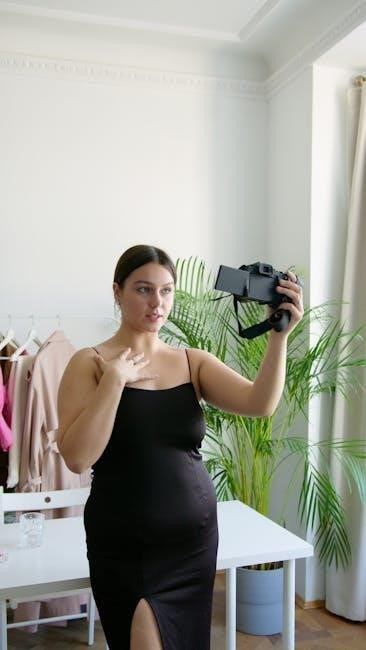DTF transfers are a popular method for customizing garments, offering vibrant designs with precise detail. Proper sizing is crucial for a professional finish, ensuring designs align perfectly with the intended placement. This guide provides essential insights into selecting the right DTF transfer sizes, covering standard dimensions for various garments and placement tips to achieve flawless results. Whether you’re working with adult tees, youth sizes, or specialized items, this resource helps you master DTF transfer sizing for optimal visual impact.
What Are DTF Transfers?
DTF (Direct-to-Film) transfers are a modern heat transfer technology used for customizing fabrics. They involve printing designs onto a special heat-transfer paper, which is then pressed onto garments using a heat press. Known for vibrant colors and durability, DTF transfers are ideal for cotton, polyester, and blended fabrics. Unlike other methods, DTF transfers work on dark and light materials without requiring additional coatings. This versatility makes them a popular choice for apparel, accessories, and promotional products. The process ensures sharp details and long-lasting designs, making it a favorite in the custom printing industry.
Why Size Matters in DTF Transfers
Proper sizing in DTF transfers ensures designs fit seamlessly on garments, enhancing both appearance and functionality. Incorrect sizes can lead to distorted images, uneven placement, or designs that overwhelm the fabric. Accurate dimensions ensure clarity, especially for intricate details, while appropriate placement maintains aesthetic balance. For example, chest logos require smaller sizes, while full-back designs need larger dimensions. Understanding size guidelines helps avoid common pitfalls, ensuring professional results and customer satisfaction. Thus, sizing is critical for achieving high-quality, visually appealing DTF transfers that meet design and garment specifications effectively.

Standard DTF Transfer Size Chart
Standard DTF transfer sizes include adult tees (10×10 to 12×12 inches), youth (8.5×8.5 to 10.5×10.5 inches), and toddler (5.5×5.5 to 7×7 inches) options, ensuring proper fit and placement.
Adult T-Shirt Sizes
Adult DTF transfers typically range from 10×10 inches to 12×12 inches, ensuring designs fit comfortably across the chest. For standard placements, a 10×10-inch transfer is ideal for centered designs, while larger sizes suit bold or full-front prints. Sleeve prints are usually smaller, around 2-3 inches wide, and left chest logos are commonly 3-4 inches wide. Proper sizing ensures the design is proportional to the garment, avoiding an overly crowded or too sparse appearance. Always measure the garment to match the transfer size for the best results.
Youth and Toddler Sizes
Youth and toddler DTF transfers are smaller to fit younger audiences. Youth sizes range from 8.5×8.5 inches for small to 10.5×10.5 inches for medium or large. Toddler transfers are typically 5.5×5.5 inches, while infant sizes are around 5 inches. These dimensions ensure designs are proportional to the garment, avoiding an overwhelming appearance. Smaller placements are ideal for chest logos or sleeve designs. Always consider the child’s age and garment size to select the right transfer size, ensuring a balanced and visually appealing result. Proper sizing enhances comfort and aesthetic appeal for younger wearers.
Common Placement Dimensions
Common DTF transfer placement dimensions vary based on design location. For chest logos, sizes range from 3-4 inches wide, while full-front designs are typically 10-12 inches wide. Sleeves usually accommodate 2-3 inches wide designs. Upper back placements are often 4-6 inches wide, and left chest placements are around 3-4 inches wide. These standard dimensions ensure designs fit proportionally on garments, enhancing both aesthetics and functionality. Proper placement alignment is key to achieving a professional, polished look in custom apparel. Always consider the garment type and design purpose when selecting placement dimensions.
Understanding DTF Transfer Placement
Proper placement ensures designs align perfectly with garment dimensions. Common placements include chest (3-4″), sleeves (2-3″), and back (4-6″). Aligning designs with seams and fabric edges enhances visual appeal and ensures professional results.
General Placement Guidelines
DTF transfers are typically placed on garments based on standard measurements to ensure a balanced and visually appealing look. For adult t-shirts, the front design is often centered and placed 3-4 inches below the collar, while the back design is positioned 4-6 inches above the bottom hem. Sleeve designs are usually 2-3 inches wide and placed 1-2 inches above the cuff. Proper alignment with seams and fabric edges is crucial for a professional finish. Always consider the garment type, fabric, and design size to achieve optimal placement and durability.
- Center chest: 3-4 inches wide, 2-3 inches tall.
- Full front/back: 10-12 inches wide, 10-14 inches tall;
- Sleeve: 2-3 inches wide, 1-2 inches above cuff.
Placement by Garment Type
DTF transfer placement varies by garment type to ensure a balanced look. For adult t-shirts, front designs are centered 3-4 inches below the collar, while back designs span 10-12 inches wide and 10-14 inches tall. Sleeves typically feature 2-3 inch wide designs just above the cuff. Youth and toddler sizes are smaller, with front designs at 8-10 inches for youth and 5.5×5.5 inches for toddlers. Hoodies may have designs on the front pouch (8-10 inches) or back (10-12 inches), with sleeve designs mid-way. Hats and accessories often have smaller, centered designs, while larger items like tote bags can accommodate bigger transfers. Always align with seams and edges for a professional finish.
- T-shirts: Front centered 3-4″ below collar; back 10-12″ wide.
- Youth: Front 8-10″ wide; toddlers 5.5×5.5″.
- Hoodies: Front pouch 8-10″ wide; back 10-12″ wide.
- Sleeves: 2-3″ wide above cuff.
- Hats/Accessories: Small centered designs.
- Tote Bags: Larger designs, 10-12″ wide.
Design Elements and Size Considerations
Design elements significantly influence DTF transfer sizing. Detailed designs require larger sizes to maintain clarity, while simpler designs can be smaller. Text-based designs should be at least 1-2 inches tall for readability, while logos and graphics need proportional sizing to avoid distortion. Complex artwork may demand larger transfers to preserve detail, but overly large designs can overwhelm the garment. Consider the design’s purpose: promotional designs may need bold, eye-catching sizes, while fashion designs might prioritize subtlety. Balancing aesthetics and functionality ensures optimal results.
- Detailed designs: Minimum size for clarity.
- Text: 1-2 inches tall for readability.
- Logos/Graphics: Proportional sizing to avoid distortion.
- Complex artwork: Larger sizes to preserve detail.
- Promotional vs. fashion designs: Size based on purpose.
Factors Influencing DTF Transfer Size
Garment type, design complexity, and target audience significantly impact DTF transfer sizing. Printer and press limitations also play a role in determining optimal transfer dimensions for various applications.
- Garment type and material affect size choices.
- Design complexity requires appropriate scaling.
- Target audience dictates size preferences.
- Printer and press capabilities limit size options.
Garment Type and Material
Garment type and material significantly influence DTF transfer size. For example, adult t-shirts typically use 11×11-inch transfers, while youth sizes range from 8.5×8.5 inches for small to 10.5×10.5 inches for medium or large. Hoodies and sweatshirts often require larger transfers, around 12×12 inches, due to their broader design space. Sleeve transfers are narrower, usually 2-3 inches wide. Material also plays a role, as certain fabrics may require adjustments for proper adhesion and durability. Understanding these factors ensures the transfer fits seamlessly with the garment’s design and intended use.
- T-shirts: Standard sizes vary by age and fit.
- Hoodies/Sweatshirts: Larger transfers for broader spaces.
- Sleeves: Narrower dimensions for a proper fit.
- Material: Affects adhesion and durability.
Design Complexity and Detail
Design complexity and detail play a crucial role in determining the ideal DTF transfer size. Intricate designs require larger transfers to maintain clarity, while simpler designs can be smaller without losing impact. High-resolution elements ensure details are visible, especially for small transfers. For example, a detailed chest logo might need a minimum of 8×8 inches, while a basic sleeve design could be as small as 2×3 inches. Balancing design complexity with size ensures the final product looks sharp and professional, regardless of placement or garment type.
- Detailed designs: Require larger transfers for clarity.
- Simple designs: Can be smaller without losing effectiveness.
- Resolution: Essential for maintaining detail in smaller sizes.
- Placement: Affects size based on visibility and garment type.
Target Audience and Intended Use
The target audience and intended use significantly influence DTF transfer size. For example, adult apparel often features larger designs (10×10 inches or more) for visibility, while youth and toddler sizes require smaller transfers (8.5×8.5 inches or less) to fit proportionally. Promotional products, like hoodies or tote bags, may need oversized designs for maximum impact, whereas delicate fabrics or baby clothes demand minimal sizing to avoid overwhelming the garment. Understanding the audience and use ensures transfers are both functional and aesthetically pleasing.
- Adult apparel: Larger designs for visibility.
- Youth/toddler sizes: Smaller transfers for proportionate fit.
- Promotional items: Oversized designs for impact.
- Delicate fabrics: Minimal sizing to avoid overwhelming.
Printer and Press Limitations
Printer and press limitations play a significant role in determining DTF transfer sizes. Most DTF printers have maximum print sizes, such as A3 or A4, restricting design dimensions. Heat presses also have size constraints, affecting how large a transfer can be applied in one press. For example, smaller presses may require designs to be split or resized. Additionally, printer resolution and ink capacity can influence detail quality, especially for larger transfers. Understanding these technical boundaries ensures designs are compatible with your equipment, avoiding wasted materials and time.
- Printer size: A3/A4 limits design dimensions.
- Heat press size: Affects transfer application size.
- Printer resolution: Impacts detail quality for larger transfers.

How to Choose the Right DTF Transfer Size
Selecting the right DTF transfer size involves measuring the garment, using templates, and considering design elements, placement, and equipment limitations. Use size charts for accuracy.

Measuring the Garment
Accurate garment measurement is crucial for DTF transfers. Measure the longest side of the design area, such as the chest width or sleeve length. Use a size chart to determine the appropriate transfer dimensions based on the garment type and intended design placement. For example, adult tees typically range from 10×10 inches for small sizes to 12×12 inches for larger sizes; Ensure the transfer fits the target area without stretching or distortion, using tools like rulers or digital templates for precision. Proper measurement ensures a professional, balanced finish.
Using Templates and Guides
Templates and guides are essential tools for achieving precise DTF transfer sizing. Use digital templates to visualize designs on virtual garment models, ensuring proper fit and placement. Printable size charts provide standard dimensions for various garment types, such as adult and youth tees, hoodies, and sleeves. These resources help prevent resizing errors and ensure designs align with the intended area. By referencing these guides, you can maintain consistency and achieve professional-quality results. They are especially useful for beginners to master DTF transfer placement and sizing efficiently.
Considering Resizing Options
Resizing options for DTF transfers allow flexibility in adapting designs to different garment types and sizes. Always check size ratios to maintain clarity and proportions. Use size charts to determine standard dimensions for various garments, such as adult tees, youth sizes, or sleeves. Test resized designs on actual garments to ensure proper fit and appearance. This step prevents costly errors and ensures the final product meets expectations. Proper resizing enhances visual appeal and guarantees professional-quality results for custom designs.

Troubleshooting Common Size-Related Issues
Common size-related issues include alignment problems, incorrect printer settings, and scaling errors. Ensure accurate measurements and test designs on actual garments to prevent sizing mistakes.
Common Mistakes in Sizing
One of the most frequent errors in DTF transfer sizing is incorrect garment measurement, leading to designs that are either too small or too large. Many creators overlook the importance of scaling designs proportionally, especially when transferring to different garment types. Additionally, failing to account for fabric shrinkage or stretch can result in misaligned prints. Another common mistake is not testing the design on an actual garment before mass production, which can lead to wasted materials and time. Using standardized size charts and templates can help minimize these issues and ensure precise results.
Solutions for Incorrect Sizes
To address incorrect DTF transfer sizes, start by re-measuring the garment and comparing it to your design. Utilize resizing tools in your design software to adjust dimensions while maintaining proportions. Consider re-printing the transfer on appropriately sized paper or film. For minor discrepancies, trimming excess material carefully can help. Always refer to sizing templates and guides specific to the garment type. Testing designs on sample fabrics before production ensures accuracy. Consulting detailed placement charts and seeking professional advice can also resolve sizing issues effectively and prevent future errors.
Mastering DTF transfer sizing ensures professional, visually appealing results. By following this guide, you can enhance your designs and achieve flawless transfers every time with precision and confidence.
Final Tips for Optimal DTF Transfer Sizing
For flawless results, always measure garments accurately and use templates to ensure proper fit. Consider design complexity and printer limitations when resizing. Test samples before bulk production to avoid errors. Use high-quality files to maintain sharp details. Double-check placement guides to align designs correctly. Adjust stroke length and speed for varying transfer sizes. Remember, precise sizing enhances both aesthetics and durability, ensuring your DTF transfers stand out and last longer. Following these tips will help you achieve professional-quality custom garments consistently.